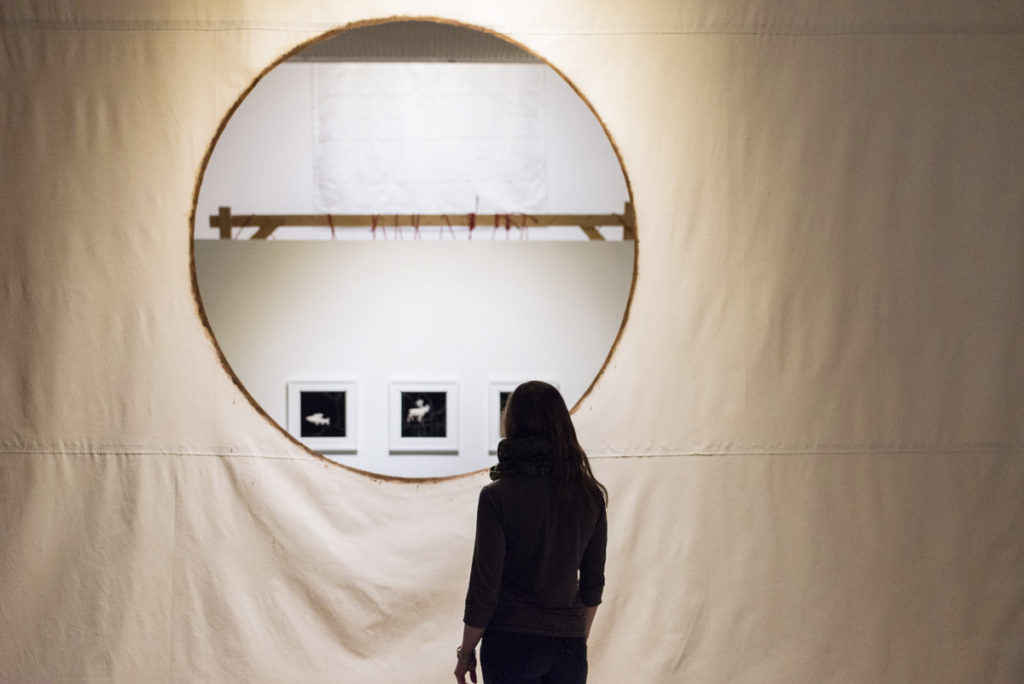Amy Malbeuf is a Métis visual artist from Rich Lake, Alberta, whose work has received significant accolades in recent years. In 2016, Malbeuf won a Lieutenant Governor of Alberta Emerging Artist Award and a William and Meredith Saunderson Prize for Emerging Artists from the Hnatyshyn Foundation; in 2017, she was longlisted for the prestigious Sobey Award. This year has already brought some big steps as well—the significant solo show “Tensions.”
“Tensions,” curated by Lorenzo Fusi for the Illingworth Kerr Gallery at the Alberta College of Art and Design in February and March, was Malbeuf’s first institutional solo exhibition in Calgary. Showing at the Illingworth Kerr was particularly meaningful for Malbeuf (and for the gallery) because she is an ACAD alumna—she earned a BFA in Drawing there in 2010, which she followed with a Native Cultural Arts Instructor Certificate from Portage College in 2012 and an MFA from the University of British Columbia Okanagan in 2016.
In “Tensions,” Malbeuf expertly considered three possible manifestations of the exhibition’s titular word: “tensions” can refer to the physical acts of stretching or straining; the states of being stretched or strained; and the mental and emotional consequences brought by trauma such as intense stress, anxiety and avoidance. In these connotations and others, “Tensions” embodied Malbeuf’s personal, familial, cultural and environmental relationships with the land as home, as sustenance and as territory. Likewise, the ways Malbeuf communities are sustained through kinship and relationship come to life.
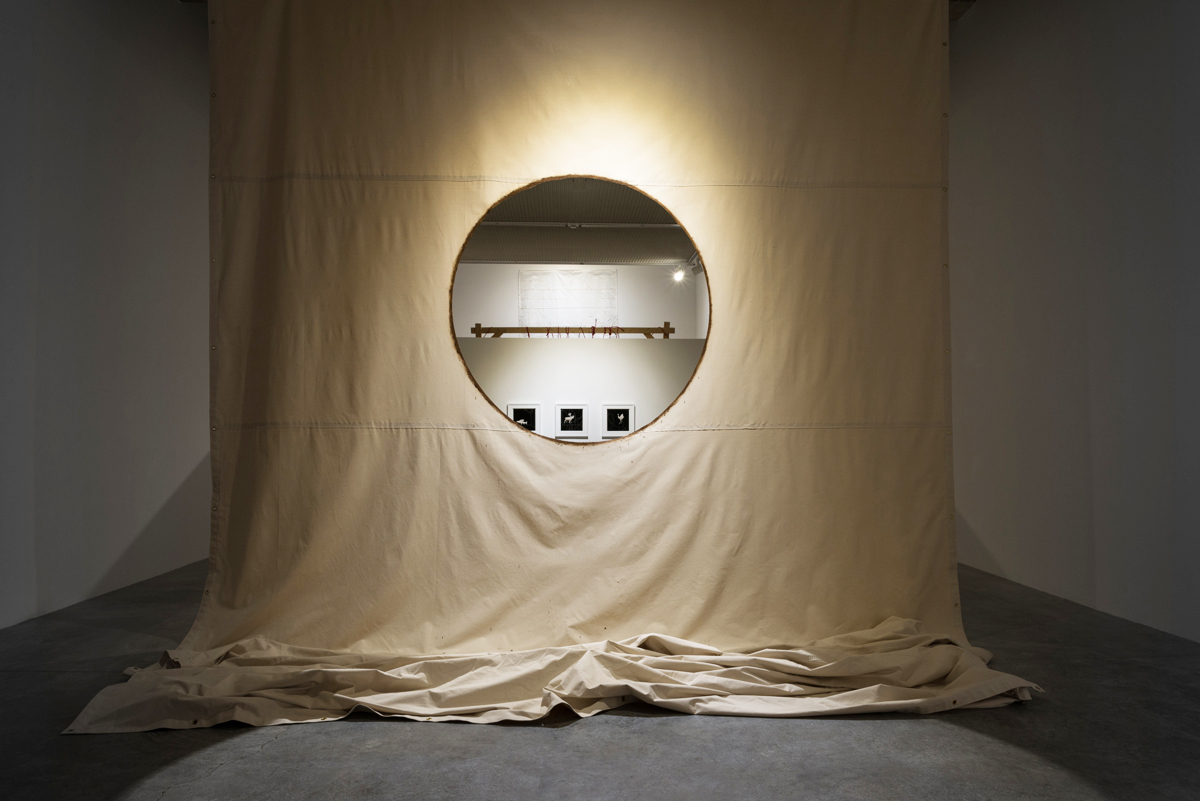 At the entrance to “Amy Malbeuf: Tensions,” viewers were met with Heart a canvas tarp pierced by a hole lined with bear grease. Visible through it were the tufted works Arctic Grayling, Woodland Caribou and Whooping Crane. Photo: Chelsea Yang-Smith
At the entrance to “Amy Malbeuf: Tensions,” viewers were met with Heart a canvas tarp pierced by a hole lined with bear grease. Visible through it were the tufted works Arctic Grayling, Woodland Caribou and Whooping Crane. Photo: Chelsea Yang-Smith
In “Tensions,” tarps became Malbeuf’s signature material. From canvas to polyurethane, monochrome colours to camouflage patterns, a wide variety of tarps were made use of by the artist.
During an exhibition tour and in conversation, Malbeuf discussed her desire to transform the tarp as a symbolical background and hold that in tension with its more functional aspects. Tarps serve as tools in a variety of rural endeavours—as groundcover and shelter, for instance, making it part of Malbeuf’s day-to-day environment. But Malbeuf’s tarps, when redeployed in her artworks, work critically and emphasize “tension” as a conceptual (not just material) grounding.
An example of Malbeuf’s symbolic and material dynamic was right at the entrance to the “Tensions” exhibition: Heart is comprised of a massive canvas tarp with a large hole set at eye level. The outline of the hole’s aperture is delineated with bear grease. Placed at the entrance of the exhibition, Heart met the viewer and directed the flow of the space. And Heart, in this context, was both a wall to get around and a vista into the show.
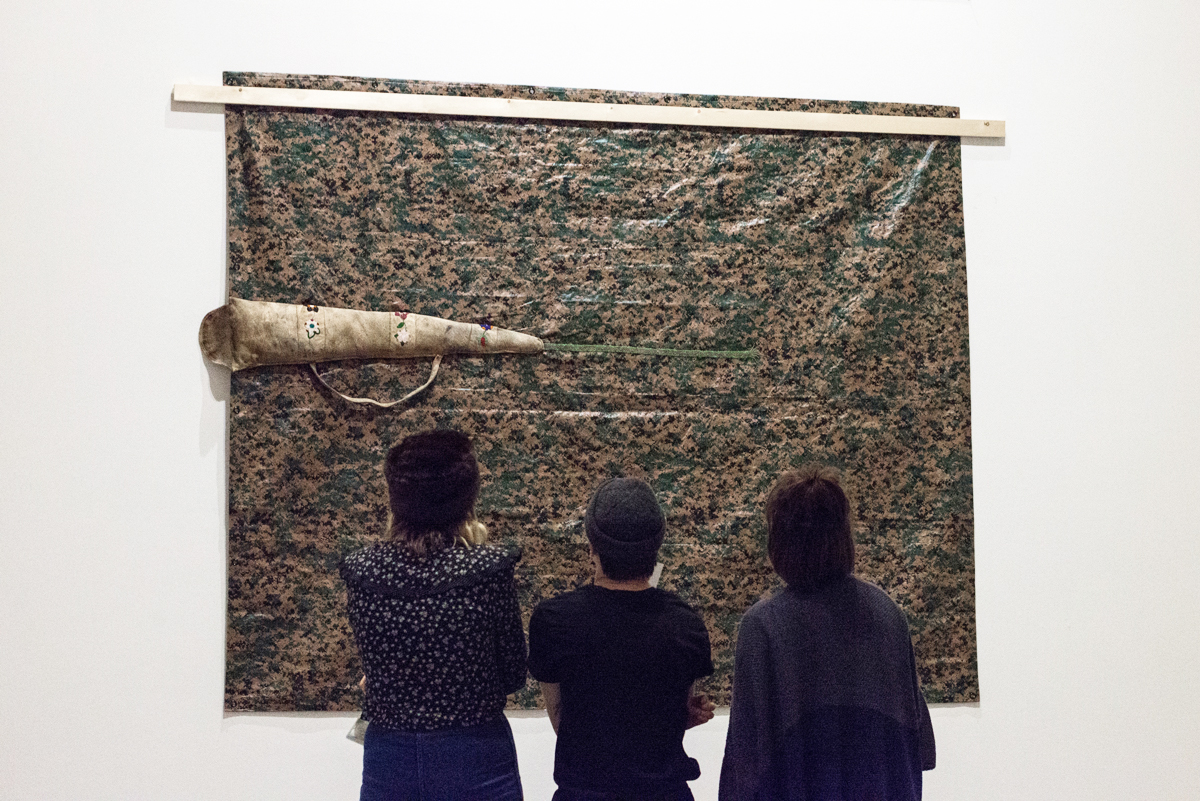 Visitors consider Amy Malbeuf‘s Woodland Camo in the exhibition “Tensions“ at Illingworth Kerr Gallery. Photo: Chelsea Yang-Smith.
Visitors consider Amy Malbeuf‘s Woodland Camo in the exhibition “Tensions“ at Illingworth Kerr Gallery. Photo: Chelsea Yang-Smith.
If tarps were Malbeuf’s signature material and symbol in “Tensions,” sculptural assemblage was her key method. Accompanying the tarps as primary material were elements collected from nature, such as ochre, branches, bear grease, rabbit fur, caribou hair, buffalo hide and bone beads. These natural objects were joined by inherited ones such as Malbeuf’s grandfather’s coyote-fur stretchers, her father’s beaded gun case, some typical orange snow fence and three embroidery hoops.
The piece Woodland Camo used this assemblage strategy to powerfully assert generational passage and cultural belief. This artwork displays the gun case of Malbeuf’s father, skillfully crafted with beaded flowers, on a very large, camouflage-patterned tarp made from polyurethane, a derivative of crude oil extraction.
This juxtaposition of two everyday objects highlights the tension between subsistence economies and capitalist exploitation. The latter mercilessly considers the land and its inhabitants as natural resources from which to profit. This contrasts starkly with Indigenous worldviews that acknowledge a shared responsibility for the well-being of all life. Both these worldviews meet, notably, in the production and use-value of the tarp.
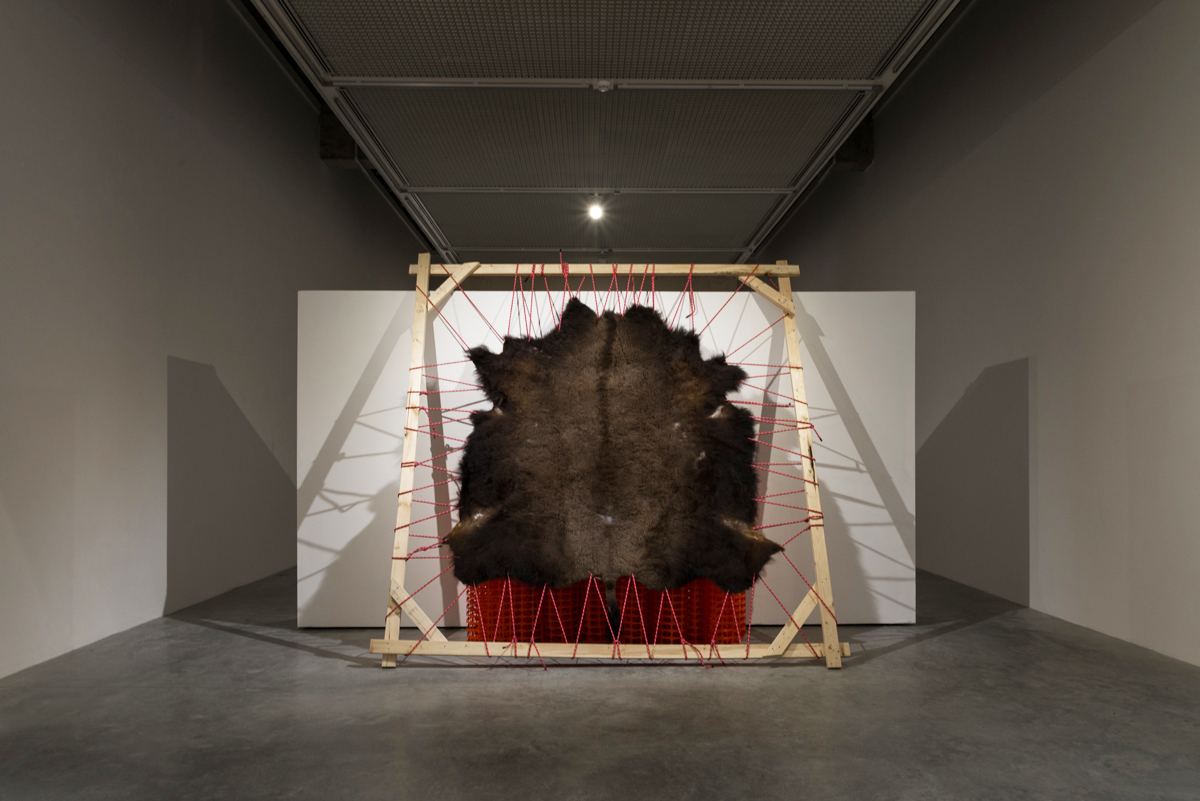 In “Amy Malbeuf: Tensions,” many surfaces and concepts were strung taut throughout the exhibition. Photo: Chelsea Yang-Smith
In “Amy Malbeuf: Tensions,” many surfaces and concepts were strung taut throughout the exhibition. Photo: Chelsea Yang-Smith
By integrating different materials, “Tensions” also described Indigenous communal interdependency and its colonial capitalist disruption, as well as the possibility for redress. In the exhibition and its works, the artist mapped generational Métis lineages with Indigenous belief systems and cultures, making visible how care and Indigenous knowledges circulate in her life as a way to unsettle the colonial narrative that portrays Indigenous peoples as incapable of caring and being cared for. Malbeuf’s practice embodies how her communities sustain environmental knowledges by valuing kinship and relatedness.
For instance, Malbeuf learned to tuft from mentor Ruby Sweetman while at Portage College; it was and is a way to enact the maintenance of Indigenous knowledge and women’s solidarity. The spaces where tufting is performed value women’s knowledge and its transference. Using caribou tufting, Malbeuf enacts Métis self-determination through adaptation and reclamation of traditional knowledges.
The artist interprets tufting traditions in a self-determined manner, creating evolving styles that clearly contest the notion that Métis traditions are static. As such, Malbeuf’s usage of tufting acknowledges that it is in constant flux and that reality requires renewal.
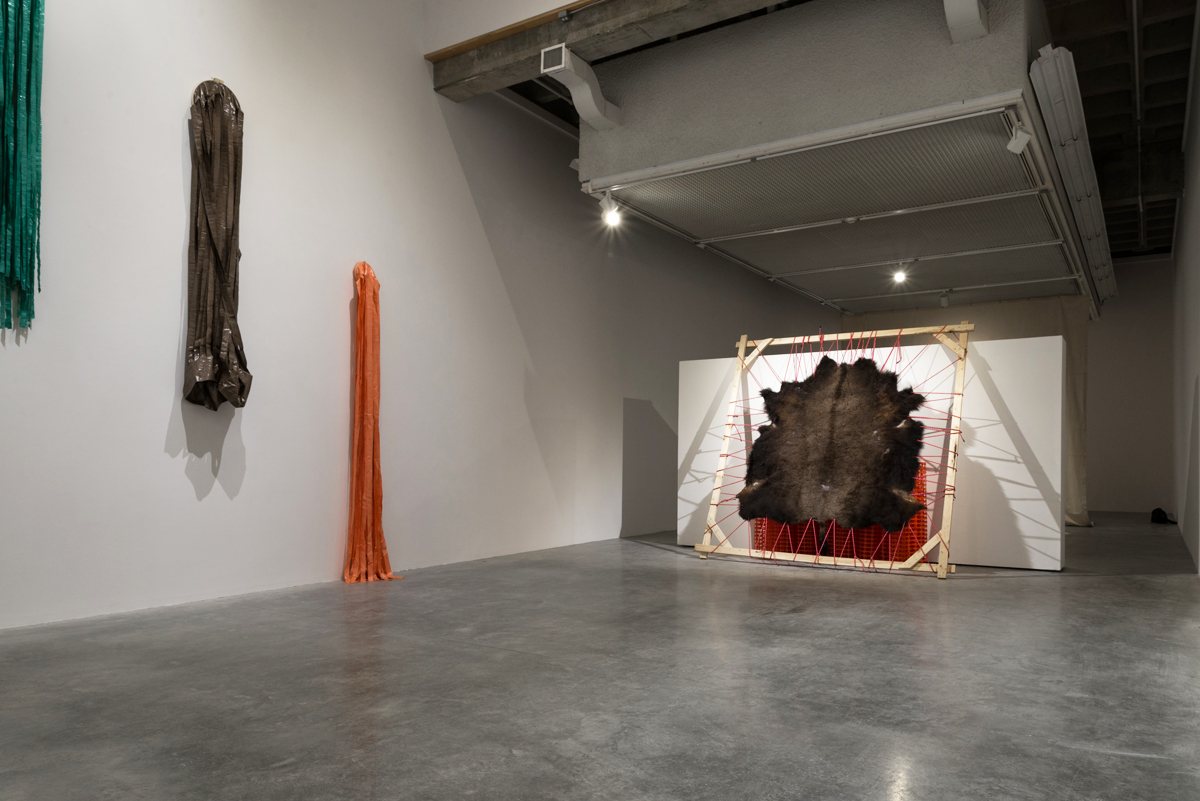 Installation view of “Amy Malbeuf: Tension” at Illingworth Kerr Gallery in Calgary. Most of the works in the show were made of tarps and other objects held under tension. Photo: Chelsea Yang-Smith
Installation view of “Amy Malbeuf: Tension” at Illingworth Kerr Gallery in Calgary. Most of the works in the show were made of tarps and other objects held under tension. Photo: Chelsea Yang-Smith
Malbeuf’s approach to caribou tufting and sculpturing—as well as evidence of its knowledges and kinship links—was highlighted in “Tensions” in three works: Arctic Grayling, Woodland Caribou and Whooping Crane. In making these works, Malbeuf became a material witness to the tensions between animals and their habitats, and the way those tensions rise when ecosystems are so severely disturbed that their ability to meet the needs of their inhabitants is undermined.
All three of these works depict their titular animals in white caribou fur, and were displayed in white frames over a black background. The Woodland Caribou, being the subject and material of its own representation here, becomes an ominous form of self-portraiture. The ground in the artworks is made of polyurethane tarps cut into thin strips and sewn onto black velvet to form lines that make up aerial maps of pipelines in northern Alberta. (Malbeuf described this in her artist’s tour of the exhibition.) The effect is one of an anxious and affective drift between denunciation, mourning and reclamation.
Yet there is not only mourning here. By enlisting traditional Métis caribou tufting, Malbeuf honours the animals she titled her artworks after as part of complex communities of kin, including humans and the land. In this practice, Malbeuf confronts the falsity that these mammal and bird populations are at risk of extinction; they will always be a part of Métis kinship structures.
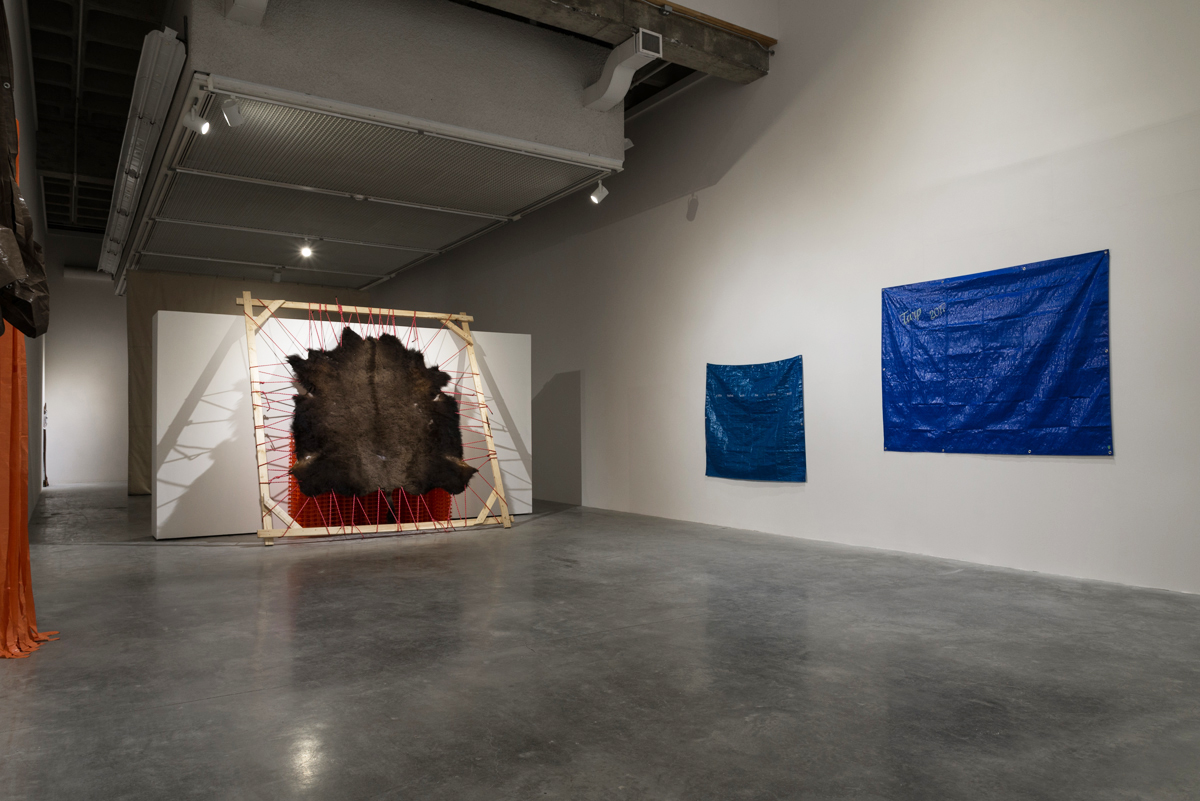 Installation view of “Amy Malbeuf: Tension” at Illingworth Kerr Gallery in Calgary. The piece Tarp 2017, with the titular words embroidered with blue beads on blue tarp, is at right. Photo: Chelsea Yang-Smith.
Installation view of “Amy Malbeuf: Tension” at Illingworth Kerr Gallery in Calgary. The piece Tarp 2017, with the titular words embroidered with blue beads on blue tarp, is at right. Photo: Chelsea Yang-Smith.
Malbeuf’s integration, in “Tensions,” of objects and techniques inherited from her family and kin also debunked genocidal narratives inscribed on Indigenous peoples; this integration in the exhibition exposed how Métis care is deeply integrated within Indigenous women’s spaces, Indigenous communities and Indigenous kinship teachings. The presentation of Malbeuf’s inherited objects in the space of a public gallery made clear that her work is shaped and supported by her family and her community. By gathering objects from her relations, including the land, Malbeuf’s practice made explicit the value of kinship and the holistic relationships that form her life.
At the same time, Malbeuf’s strategies in “Tensions” suggested how those relations and knowledges can be (and have been) commodified in unfair ways under capitalism.
The work Tarp 2017 in particular—with its tiny glass beads arranged to spell out those words in a serif font upon an otherwise bare blue tarp—reminds the viewer that commodification of Indigenous objects is not something of the past; it remains very present in global leisure and tourism industries that appropriate Indigenous women’s art and labour. The ethical acquisition of Indigenous arts and crafts is not yet a goal of commercial fairs. And tourism still produces foreign domination and dependency, creating conflict and resentment among local Indigenous peoples as a result of that industry’s impacts.
Of the cultural tensions at the centre of the artwork Tarp 2017, Malbeuf says she wanted to emphasize “commodification of Indigenous women’s art and labour in relation to colonialism and capitalism throughout history and in current times. The labeling Tarp 2017 is a reference to small trinkets, boxes, purses, wall-hangings etc., that are labeled/beaded by artists in a similar manner created for competitions and fairs, and often consumed by a mostly non-Indigenous audience.”
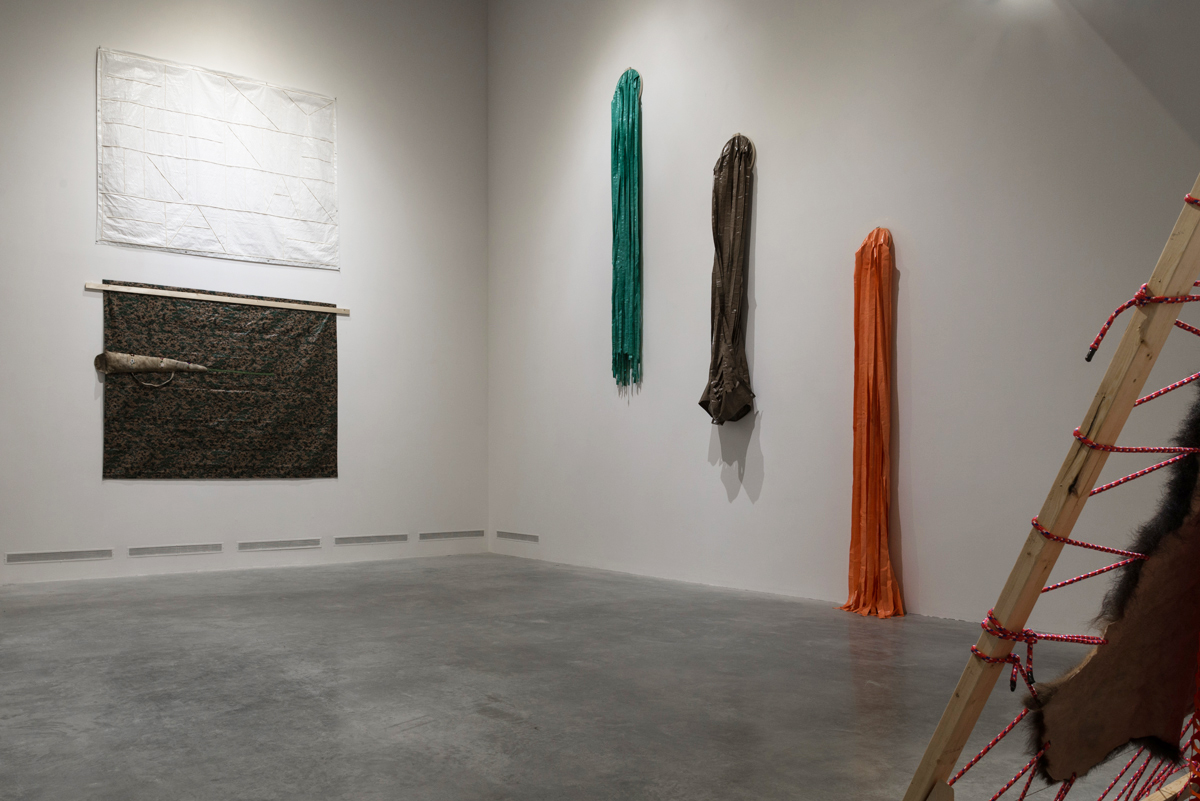 Installation view of “Amy Malbeuf: Tension” at Illingworth Kerr Gallery in Calgary. Photo: Chelsea Yang-Smith.
Installation view of “Amy Malbeuf: Tension” at Illingworth Kerr Gallery in Calgary. Photo: Chelsea Yang-Smith.
Ultimately, in form and in content, “Tensions” was about the relations upon which all life depends. Malbeuf’s position as a proud Métis woman artist, with knowledge grounded in the land, was forcefully expressed through her unique and creative take on traditional practices such as caribou tufting and beading. At the same time her tarpaulins nevertheless remind viewers that she, and we, continue to exist in tension under an exploitative colonial narrative.
Mireille Perron is an artist, writer and editor based in Calgary, where she teaches at the Alberta College of Art and Design. Perron is the founder of the Laboratory of Feminist Pataphysics; LFP promotes social experiments that masquerade as artworks/events.

